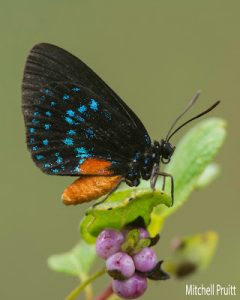This is the latest in a series of guest posts from Mitchell Pruitt, a recent U of A honors graduate and current graduate student in the Department of Biological Sciences. An avid bird watcher for seven years, Mitchell – at age 17 in 2011 – ranked No. 4 on a list of people who had seen the most birds in Arkansas, when he documented 311 avian species. In this dispatch, Mitchell describes his recent butterfly sightings.
Standing, talking to a photographer friend and enjoying the beauty of the first sunny day all week, a streak of bright blue darted past my eyes. The color was electric, rivaling the azures of morpho butterflies in the tropics, though this bug was much smaller. Just past our heads, it landed in a patch of late boneset, where we had already been enjoying the butterfly diversity.
Now all attention was turned to the new arrival: a great purple hairstreak butterfly, shown in the main image above. Not a large butterfly, but big for its family, nearly twice the size of some hairstreaks. Most are less than an inch tall. This particular species is uncommon in both Arkansas and elsewhere in its range. The great purple hairstreak lays its eggs on mistletoe. With the abundance of that particular plant in the Ozark region of Arkansas, one would think the species to be much more common, but for some reason they aren’t. In fact, this was the only one I’ve ever seen.
My great purple hairstreak was seen at a local restored and mitigated wet prairie site. Calling it amazing is an understatement. In less than 10 years of restoration work, the 46-acre site functions largely as it did before it was settled in the 1830s. Both flora and fauna have bounced back, including several rare or unusual species thought lost to the area. In late summer and early fall, the prairie abounds with insect diversity, with an emphasis on the butterflies.
It was at this same prairie, three days before the great purple hairstreak, that I found another rarity of the same family: white M hairstreak. This is another large hairstreak with beautiful blue upper wings, a trait exhibited by several other members of the family. However, in almost all species the color remains hidden. Hairstreaks keep their wings held tightly upright, providing quick flashes of the blue only in flight.
Another species on this particular prairie is the red-banded hairstreak, a specialty of the southeastern United States. Unlike most caterpillars, which feed on living host plants, red-banded hairstreak caterpillars feed on fallen and decaying leaves of sumac and certain oaks. This is a hairstreak I always look forward to seeing. It flies from April to October, but I seem to find the largest numbers after a final big hatch in late summer. More of a bluish-gray, this tiny butterfly sports the namesake thick orange band, running through both the hind and forewings, accented with an array of black spots and thinner white bands.
I’ve observed plenty of other hairstreaks in my travels.
It was in one particularly dry pine forest on the island of Abaco, in the Bahamas, that I saw nearly 50 atala hairstreaks. Like the great purple, the atala is classified as one of the “large tropical” hairstreaks. In nature, it’s often hard to find a creature that captures the essence of beauty in its entirety. The atala is the whole package. The butterfly is a silky, jet black – staring at this bug is like staring into a black hole. As the sun works its way through a patchwork of leaves, light hits tiny scales of aquamarine. The atala is like looking at a field of stars on a moonless night. Two constellations of spots, one on the hind wing and one on the body, stand in contrast to the bright orange abdomen and orange-red splotch on the lower hind wing.
You don’t have to travel far to get your own hairstreak fix. There are about 5,500 species in the family Lycaenidae known to exist in almost every corner of the globe, from backyards to wetland prairies to the depths of remote jungles.







You must be logged in to post a comment.